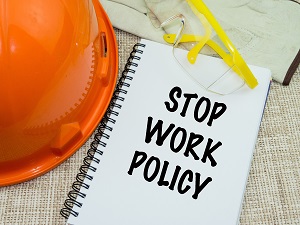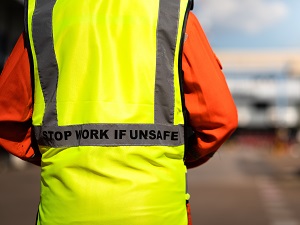Stop Work Authority is a policy that organizations can adopt to empower employees, at any level, to immediately halt a job or task at work when a hazardous situation appears imminent, without fear of retribution.

Stop Work Authority (SWA), also known as Right to Refuse (RTR), is not required by OSHA, but there are many benefits to implementing a procedure that gives employees the right to stop unsafe or unhealthful working conditions. Adding Stop Work Authority to a health and safety program is a good way to strengthen the safety culture at an organization when workers know they can exercise SWA without repercussion.
Because work conditions can change, having a program in place like Stop Work Authority encourages employee involvement in hazard observation and increases the chances that hazards are identified well before they become near misses or tragic incidents.
The Stop Work Authority procedures should cover everyone at a work location or on the job site including employees, contractors, subcontractors, and visitors. Stop Work Authority does not only apply to extremely dangerous work situations or obviously unsafe behavior like explosion hazards or when someone becomes distracted and walks under a heavy load. Depending on the circumstance, correcting hazards after work has been stopped can also include easy fixes like instructing personnel to wear the proper PPE or moving a tripping hazard.
Stop Work Authority provides
- an additional layer of protection for people and property.
- a framework for workers, subcontractors, and management to respect safe work.
- a procedure that protects individuals from negative consequences when they exercise their right to refuse dangerous work.
- the specific steps workers can take to protect themselves and their co-workers from a potentially hazardous situation.
- the organization with empowered, competent workers who have the responsibility, obligation, and right to stop work if they believe it will create a dangerous situation.

It is not enough to just declare that Stop Work Authority now exists within an organization. Clear communication of the SWA policies is crucial, including:
- the exact steps an employees should take and how the entire process works from start to finish
- examples of what kinds of work situations may require work to stop
- the obligation and responsibility that workers have to halt work before an incident happens
- assurance that there are to be no negative consequences, from the company, management or co-workers after a worker uses their authority to stop work
- a zero tolerance for bullying or ridicule towards anyone who uses their authority to stop work
- training requirements
There may be obstacles and challenges that employees need to overcome as they begin to actively participate in a Stop Work Authority program. The following excuses are not good reasons for any worker to fail to use their authority to stop work when unsafe actions or a hazardous situation arises at work.
- Fear of alienating a co-worker by calling them out on an unsafe act.
- There is a sense of urgency to getting the work done and stopping work would cause a delay.
- An unsafe act may be performed by someone with more experience, and you feel like it is not your place to call attention to the risky behavior.
- Anxiety that you have misinterpreted the situation.
- Peer pressure influencing you not to speak up.
- Fear of embarrassment or ridicule.
- Unclear understanding of the SWA process or what unsafe acts may be deemed worthy of stopping.
- Worry that stopping work may impact production or the ability to meet a deadline.
- Other workers are present and no one else is saying anything.
- Assuming you don’t have the authority to stop work if you witness unsafe behavior or a dangerous situation.
- Accepting “we’ve always done it this way” as an excuse for performing work in an unsafe manner.
- Fear of angering a supervisor or management.

Every organization will set up their Stop Work Authority program differently, but the general steps of a SWA procedure are as follows:
- Stop the work. When an unsafe action or situation is observed, the work is immediately halted.
- Notify the affected personnel and supervisor. Provide a clear explanation of the reason why the work was stopped. Take immediate action to make the area safe.
- Investigate the reason why the work was halted. Review and discuss the situation and come to an agreement on the stop work action.
- Correct the unsafe behavior or situation. Hazards should be eliminated before work resumes.
- Resume the work. After corrective actions have been completed all affected personnel should be notified that work can continue.
- Monitor and follow-up. While immediate corrections may have eliminated the hazard, additional actions may be implemented to prevent future occurrences. Preventative actions may include monitoring activity, root cause analysis, additional training, safety program updates, follow-up inspections, further investigation, targeted safety meetings, or documentation.
Even if a Stop Work Authority plan has not been implemented, OSHA states that workers always have the right to refuse dangerous work. Your right to refuse to do a task is protected if all the following conditions are met:
- Where possible, you have asked the employer to eliminate the danger, and the employer failed to do so.
- You refused to work in "good faith." This means that you must genuinely believe that a reasonable apprehension of death or serious injury exists.
- A reasonable person would agree that there is a real danger of death or serious injury.
- There isn't enough time, due to the urgency of the hazard, to get it corrected through regular enforcement channels, such as requesting an OSHA inspection.
OSHA Standard 1977.12(b)(2) Occasions might arise when an employee is confronted with a choice between not performing assigned tasks or subjecting himself to serious injury or death arising from a hazardous condition at the workplace. If the employee, with no reasonable alternative, refuses in good faith to expose himself to the dangerous condition, he would be protected against subsequent discrimination.
Employees can take the following actions if a Stop Work Authority procedure is not currently in place.
- Ask the employer to correct the hazard, or to assign other work.
- Tell the employer that you won't perform the work unless and until the hazard is corrected.
- Remain at the worksite until ordered to leave by your employer.


